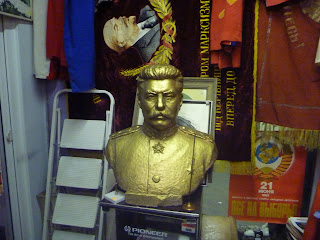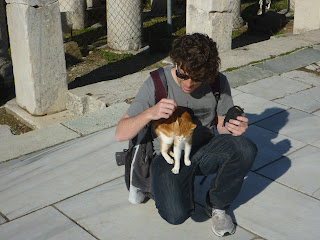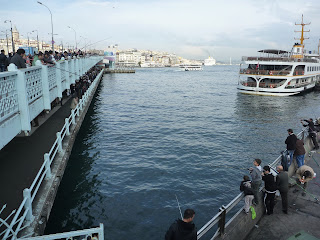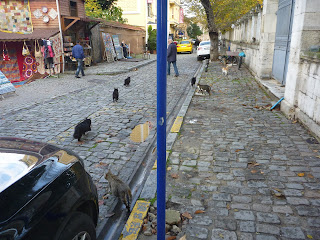Recently, every city I’ve been to has had an old town. And old towns
have Christmas markets. Kitschy, overpriced and lame.
Yet, and begrudgingly, I was beginning to feel that creeping sensation
of Christmas cheer. This was something I had wished to avoid, as in accepting
this, it needed to be reconciled with the fact that for the first time I would
be spending that most festive of days in a hostel.
 |
| Snowman, Riga |
Accordingly, it had taken some choosing to sort out where I wanted to
stay—the cheapest, smallest hostel available—and lo, nestled above the
McDonald’s near the bus station in Riga was my Christmas home.
After a long and boring bus ride from Tallinn, it was late and I had
not much time to use the fading light of gloaming to quickly power around the
city and come to terms with it. Back at the hostel I met Laurence, a recently
single Kiwi man backpacking for the first time at the tender age of 28. He,
along with the girls who ran the hostel, Dace and Daiga, along with two British
gents, Ara and Doug, would be the core of my surrogate Christmas family.
 |
| Christmas market, Riga |
In the -12 weather it was an ambitious plan to try and endure a walking
tour, and we arrived at the meeting point at 11am so that I had time to go up
to the top of the church to get what was apparently quite a nice view of the
old town. Sadly, the church was closed, and outside it was a lonely looking man
spruiking the old town walking tour, which was meant to start presently.
 |
| Santa dog |
So it was that we ambled quite briskly in order to combat the chill,
learning of Riga’s difficulty in establishing sovereignty as it spent the years
being variously occupied due to its convenient position for trade. This was as
we made our way to the central market, which is truly something to behold.
Formed in several old Zeppelin hangars and with enormous sections for
various proteins, vegetables and miscellanea, we were treated to some variously
pickled pickles—the garlic ones having enough power to burn eyes—and sampled
some kvass. Kvass is a curious drink of fermented rye bread, mildly alcoholic, coca cola-coloured,
carbonated, and malty, it is almost reminiscent of a Dr Pepper. Apparently it
is so popular in the Baltics Coke started producing it, as it was outselling
soft drinks in summer.
 |
| Kvass with Laurence |
Amidst the piles of ancient televisions, prehistoric tools, mobiles so
old they aren’t even retro, and arcana from various occupations, there are no
doubt bargains to be had, but I was quite content to leave them for the more
ambitious, simply enjoying staring and fondling the mismatched bounty of
unknown providence. Sadly, I couldn't find the person selling kidneys.
 |
| Black market |
After some not entirely interesting information about architecture and
neosomething-or-rather Russian Tsar facades, we made it to the hockey rink.
Toms, as it turns out, was a player on the Latvian national team before he blew
his knees out. Thus every hockey game he sees is bittersweet, supporting and
watching his ex-team mates play out his passion. Sadly he was unable to join us
today, as he had another tour to run, despite our entreaties for him to skip it
and hang out.
The game itself was quite impressive if only because the crowd of 5600
was more raucous than some crowds I’ve been a part of that were five times the
size. Replete with t-shirt cannons, American-style annoying music-bytes and
drum-wielding passionate fans, it was a sensory experience. One only enhanced by
the nasty mulled wine we sipped, watching the locals double fist beer and
straight whisky.
 |
| Di-na-mo |
So it was Christmas, and waking late and having half of my surrogate
family head out in search of breakfast—something that turned into a multiple hour
odyssey—rendered the morning quite un-Christmas-y. Once they returned it was
time for some grocery shopping, and so we decamped to the central market to
source the requisite means to create some Latvian Christmas peas, sausage and sauerkraut,
roast chicken and veg, mashed potato and mulled wine.
Thus began the festivities and the snowballing of Christmas spirit, the
cooking a challenge given the tiny kitchen and insufficient number of pans.
Nonetheless we soldiered on, my impulse decision to try to cook a traditional
Latvian Christmas dish of peas without ever having seen or tasted it
surprisingly successful, and the frenzy of creation seeing only one finger
sliced—not mine.
 |
| Laurence, Dace, Doug, Ara |
Eventually we gorged on all the food we had prepared. The family was
fortified by a trio of Columbians, Dace and Daiga’s friend, as well as a Dutch
guy Ara and Doug had met at a bar. The gifts we had bought for Secret Friend—Latvian
Secret Santa—were distributed via lottery and we settled down to drinking and
eating the day away, my Australian-homage summer pudding for dessert.
After this very Latvian Christmas is was a tediously long bus to
Kaunas, Lithuania. It was here I discovered my plan to catch a bus to Warsaw
for the 29th to meet up with the person I was to be couchsurfing
with was in jeopardy given all the buses had been booked-out. So it was a
flustered attempt to secure transport that consumed my evening, settling on a
silly train trip that involved changing at the border as the soviet railway of
Lithuania is a different gauge to that of Poland.
 |
| Christmas dinner |
The next day I met up with Kristina, a local who had offered to hang
out with me through couchsurfing. After wandering around the old town by myself
in the morning, her local knowledge was utilised as we went slightly off track
to a monastery about 20 minutes out of town, before eating apple pie at the
yachting club that is no doubt much more pleasant in summer.
Indeed, that was the theme of her guided tour of Kaunas as we navigated
slippery footpaths of black ice and slushy puddles that saw my boots sodden and
toes turning pink. So we escaped the inclement conditions by hiding in a couple
of bars, drinking a bit too much and admiring the ridiculously ugly ex-soviet
factory turned church that looms over the city, illuminated for all to see.
 |
| Big ass Christmas tree, Kaunas |
What is irritating about Kaunas, however, only became apparent on the
morning of my departure. The place has no exchange offices. If you want to
change your Lithuanian Lits into a more useful currency you have to go to a
bank and join the enormous queue of geriatrics that moves as glacially as their
walking-frame-supported shuffle. So with time a-dwindling, frustrated at the
chunk of potential euros still in my wallet, I jumped on the wrong bus and
ended up going basically the opposite direction from the train station.
Realising this, it was time to catch a cab in order to not miss my
train. So I guess the leftover currency wasn’t too useless. But that is
secondary to the true tale here.
I have had many cabbies in my travels and indeed, back home. Some have
been creepy old men, telling me of their plans to import Estonian brides, or
maintained lascivious streams of filth at passing women. One bragged of having
slept with Lebron James’ mother, and one even made my sister cry. Some have
smelled, some have been mid-beer when I got in, but all of them have been able
to take me to the train station.
 |
| Ghetto hoopin' |
Not this one.
Even after I slowly and loudly—while pointing at it on a fuck-off-huge-A3
map of the city in which he makes his cab-driverly living—read the name of the
streets that make the intersection where the train station sits, large and
obvious.
To better understand this incompetence, keep in mind that Kaunas is not
big. It is a city of 350,000. Hardly a maze-like metropolis. Moreover, going to
and from the old town there are two roads, each running in one direction.
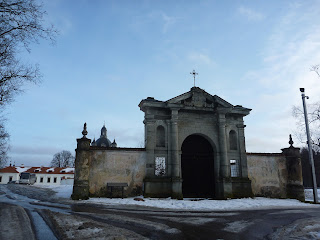 |
| Monastery |
Even if he understood only the gist of the map, I had pointed in the
direction away from the old town, indeed, at where the train station was
located. Yet my cabbie decided to turn onto the one way road towards the old
town.
The complete opposite direction to that in which I wished to go.
What the fuck.
Finally we pulled over and after an extensive conference were on the
same page. “Ahhhh,” he exclaimed, “chka-chka chka-chka,” miming a train.
9 long and boring hours later I was in Warsaw.





